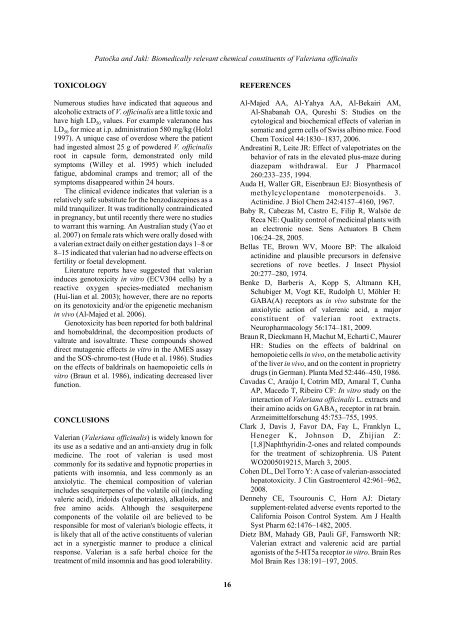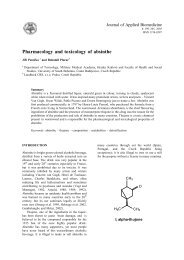Biomedically relevant chemical constituents of Valeriana officinalis
Biomedically relevant chemical constituents of Valeriana officinalis
Biomedically relevant chemical constituents of Valeriana officinalis
You also want an ePaper? Increase the reach of your titles
YUMPU automatically turns print PDFs into web optimized ePapers that Google loves.
TOXICOLOGY<br />
Patočka and Jakl: <strong>Biomedically</strong> <strong>relevant</strong> <strong>chemical</strong> <strong>constituents</strong> <strong>of</strong> <strong>Valeriana</strong> <strong>of</strong>ficinalis<br />
Numerous studies have indicated that aqueous and<br />
alcoholic extracts <strong>of</strong> V. <strong>of</strong>ficinalis are a little toxic and<br />
have high LD 50 values. For example valeranone has<br />
LD 50 for mice at i.p. administration 580 mg/kg (Holzl<br />
1997). A unique case <strong>of</strong> overdose where the patient<br />
had ingested almost 25 g <strong>of</strong> powdered V. <strong>of</strong>ficinalis<br />
root in capsule form, demonstrated only mild<br />
symptoms (Willey et al. 1995) which included<br />
fatigue, abdominal cramps and tremor; all <strong>of</strong> the<br />
symptoms disappeared within 24 hours.<br />
The clinical evidence indicates that valerian is a<br />
relatively safe substitute for the benzodiazepines as a<br />
mild tranquilizer. It was traditionally contraindicated<br />
in pregnancy, but until recently there were no studies<br />
to warrant this warning. An Australian study (Yao et<br />
al. 2007) on female rats which were orally dosed with<br />
a valerian extract daily on either gestation days 1–8 or<br />
8–15 indicated that valerian had no adverse effects on<br />
fertility or foetal development.<br />
Literature reports have suggested that valerian<br />
induces genotoxicity in vitro (ECV304 cells) by a<br />
reactive oxygen species-mediated mechanism<br />
(Hui-lian et al. 2003); however, there are no reports<br />
on its genotoxicity and/or the epigenetic mechanism<br />
in vivo (Al-Majed et al. 2006).<br />
Genotoxicity has been reported for both baldrinal<br />
and homobaldrinal, the decomposition products <strong>of</strong><br />
valtrate and isovaltrate. These compounds showed<br />
direct mutagenic effects in vitro in the AMES assay<br />
and the SOS-chromo-test (Hude et al. 1986). Studies<br />
on the effects <strong>of</strong> baldrinals on haemopoietic cells in<br />
vitro (Braun et al. 1986), indicating decreased liver<br />
function.<br />
CONCLUSIONS<br />
Valerian (<strong>Valeriana</strong> <strong>of</strong>ficinalis) is widely known for<br />
its use as a sedative and an anti-anxiety drug in folk<br />
medicine. The root <strong>of</strong> valerian is used most<br />
commonly for its sedative and hypnotic properties in<br />
patients with insomnia, and less commonly as an<br />
anxiolytic. The <strong>chemical</strong> composition <strong>of</strong> valerian<br />
includes sesquiterpenes <strong>of</strong> the volatile oil (including<br />
valeric acid), iridoids (valepotriates), alkaloids, and<br />
free amino acids. Although the sesquiterpene<br />
components <strong>of</strong> the volatile oil are believed to be<br />
responsible for most <strong>of</strong> valerian's biologic effects, it<br />
is likely that all <strong>of</strong> the active <strong>constituents</strong> <strong>of</strong> valerian<br />
act in a synergistic manner to produce a clinical<br />
response. Valerian is a safe herbal choice for the<br />
treatment <strong>of</strong> mild insomnia and has good tolerability.<br />
16<br />
REFERENCES<br />
Al-Majed AA, Al-Yahya AA, Al-Bekairi AM,<br />
Al-Shabanah OA, Qureshi S: Studies on the<br />
cytological and bio<strong>chemical</strong> effects <strong>of</strong> valerian in<br />
somatic and germ cells <strong>of</strong> Swiss albino mice. Food<br />
Chem Toxicol 44:1830–1837, 2006.<br />
Andreatini R, Leite JR: Effect <strong>of</strong> valepotriates on the<br />
behavior <strong>of</strong> rats in the elevated plus-maze during<br />
diazepam withdrawal. Eur J Pharmacol<br />
260:233–235, 1994.<br />
Auda H, Waller GR, Eisenbraun EJ: Biosynthesis <strong>of</strong><br />
methylcyclopentane monoterpenoids. 3.<br />
Actinidine. J Biol Chem 242:4157–4160, 1967.<br />
Baby R, Cabezas M, Castro E, Filip R, Walsöe de<br />
Reca NE: Quality control <strong>of</strong> medicinal plants with<br />
an electronic nose. Sens Actuators B Chem<br />
106:24–28, 2005.<br />
Bellas TE, Brown WV, Moore BP: The alkaloid<br />
actinidine and plausible precursors in defensive<br />
secretions <strong>of</strong> rove beetles. J Insect Physiol<br />
20:277–280, 1974.<br />
Benke D, Barberis A, Kopp S, Altmann KH,<br />
Schubiger M, Vogt KE, Rudolph U, Möhler H:<br />
GABA(A) receptors as in vivo substrate for the<br />
anxiolytic action <strong>of</strong> valerenic acid, a major<br />
constituent <strong>of</strong> valerian root extracts.<br />
Neuropharmacology 56:174–181, 2009.<br />
Braun R, Dieckmann H, Machut M, Echarti C, Maurer<br />
HR: Studies on the effects <strong>of</strong> baldrinal on<br />
hemopoietic cells in vivo, on the metabolic activity<br />
<strong>of</strong> the liver in vivo, and on the content in proprietry<br />
drugs (in German). Planta Med 52:446–450, 1986.<br />
Cavadas C, Araújo I, Cotrim MD, Amaral T, Cunha<br />
AP, Macedo T, Ribeiro CF: In vitro study on the<br />
interaction <strong>of</strong> <strong>Valeriana</strong> <strong>of</strong>ficinalis L. extracts and<br />
their amino acids on GABA A receptor in rat brain.<br />
Arzneimittelforschung 45:753–755, 1995.<br />
Clark J, Davis J, Favor DA, Fay L, Franklyn L,<br />
Heneger K, Johnson D, Zhijian Z:<br />
[1,8]Naphthyridin-2-ones and related compounds<br />
for the treatment <strong>of</strong> schizophrenia. US Patent<br />
WO2005019215, March 3, 2005.<br />
Cohen DL, Del Torro Y: A case <strong>of</strong> valerian-associated<br />
hepatotoxicity. J Clin Gastroenterol 42:961–962,<br />
2008.<br />
Dennehy CE, Tsourounis C, Horn AJ: Dietary<br />
supplement-related adverse events reported to the<br />
California Poison Control System. Am J Health<br />
Syst Pharm 62:1476–1482, 2005.<br />
Dietz BM, Mahady GB, Pauli GF, Farnsworth NR:<br />
Valerian extract and valerenic acid are partial<br />
agonists <strong>of</strong> the 5-HT5a receptor in vitro. Brain Res<br />
Mol Brain Res 138:191–197, 2005.





